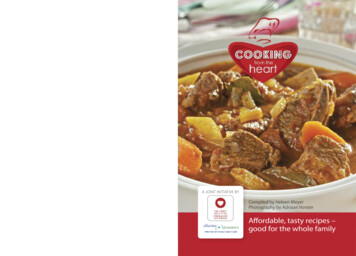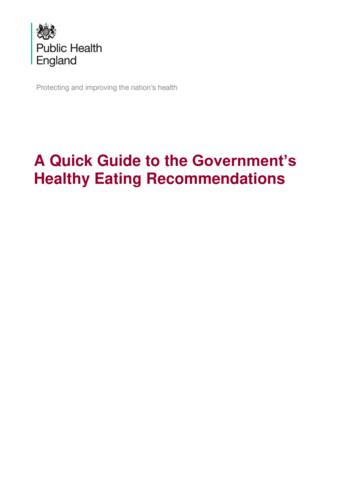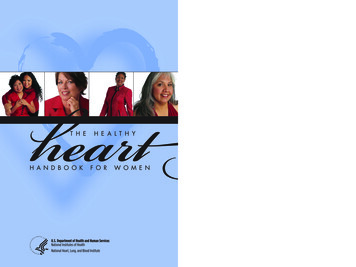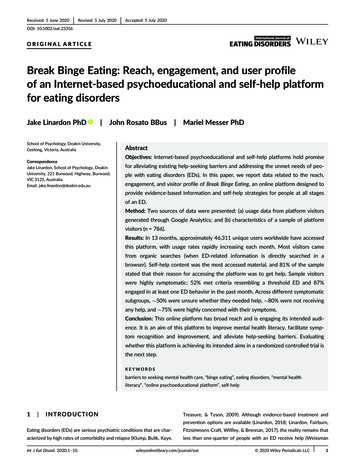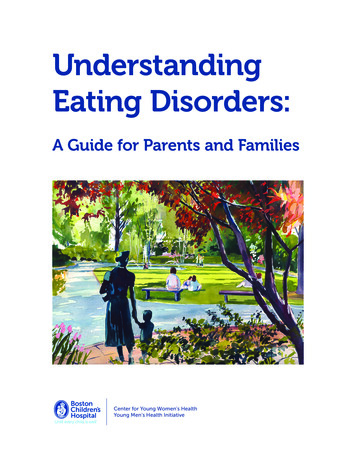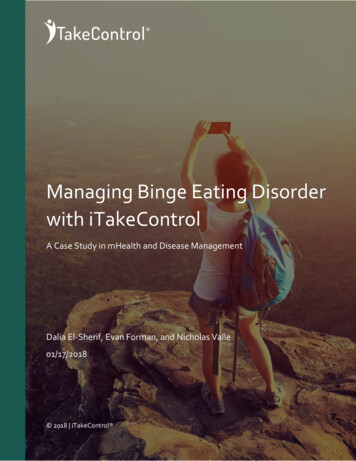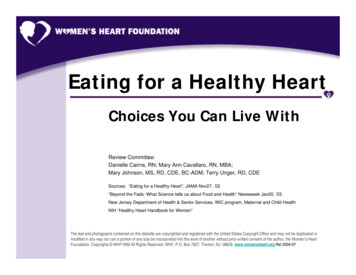
Transcription
Eating for a Healthy HeartChoices You Can Live WithReview Committee:Danielle Cairns, RN; Mary Ann Cavallaro, RN, MBA;Mary Johnson, MS, RD, CDE, BC-ADM; Terry Unger, RD, CDESources: “Eating for a Healthy Heart”, JAMA Nov27, ’02“Beyond the Fads: What Science tells us about Food and Health” Newsweek Jan20, ’03New Jersey Department of Health & Senior Services, WIC program, Maternal and Child HealthNIH “Healthy Heart Handbook for Women”The text and photographs contained on this diskette are copyrighted and registered with the United States Copyright Office and may not be duplicated ormodified in any way nor can a portion of any size be incorporated into the work of another without prior written consent of the author, the Women’s HeartFoundation. Copyrights WHF1999 All Rights Reserved. WHF, P.O. Box 7827, Trenton, NJ. 08628. www.womensheart.org Rel 2004-07
Goals Understand the principles of healthy eating andways to help prevent heart disease and obesity Learn how to incorporate healthy eating into abusy lifestyle Realize that one eating plan is not foreverybody
Cholesterol Plaque Buildup it starts in childhoodGraphic courtesy of Health Edco Corporation. Used by permission.
America is SufferinganObesity EpidemicWe are consuming more calories, growing moreobese, suffering more diabetes and high bloodpressure – all risk factors for heart disease
“The obesity epidemic in America is theterror within”- Richard Carmona, MD, Surgeon General 2002-06 60 million people in U.S. are overweight or obese.9 million children are affected. 20% of healthcare dollars are spent on obesity – 4trillion dollars spent of our gross national product Unless we do something about obesity, themagnitude of this dilemma will dwarf the terror of9/11. This could be the unhealthiest generation ever inour history. Our once vibrant society is perishing now as ourchildren are deteriorating before our eyesGo to http://www.youtube.com/watch?v cPNw-kIPy8I
Photo from Photosearch.com
Photo found with google search on “photos of obesity”
Research Supports 3 Dietary Strategies:1. Substitute monounsaturated fats forsaturated and trans-fats2. Increase consumption of omega 3 fattyacids from fish, fish oil supplements or aplant source like flax seed oil3. Consume a diet high in fruits, vegetables,nuts, and whole grains and low in refinedgrain products.- Harvard School of Public Health, Channing Laboratory, Brigham andWomen’s Hospital and Harvard Medical School
USDA FoodPyramid(replaced in 2005)BadGood Attempts to showbalance in eating froma variety of foods Encourages fruit andvegetable intake Didn’t differentiate betweenhealthy and unhealthy fats Lumps high protein foodstogether – does not separateout red meat Balance of calories could comefrom less healthy foodsi.e.white sugar, white flour.
USDA “My Pyramid”(introduced in 2005) Online version to customize nutritional needs Includes exercise component Still not clear with– types of foods to eat– types of foods to avoid– portion size
Healthy Fats While people once thought all fat was bad,science is now showing that omega-3 fattyacids is good for the heart and vital to goodhealth (i.e. wild salmon, tuna, mackerel,sardines). Monounsaturated fat protects HDL levels (i.e.olive oil) A combination of healthy fats, oils and plantsterols/stenols* can be purchased in a spread(i.e. Smart Balance , Benecol , Take Control ) Keep in mind: Fats are high in calories and cancontribute to weight gain.
Adults Aim for 7-9servings aday ofVegetables
Adults - Aim for 2-4 servings aday of whole Fruits
Eat more beans, nuts and legumes
Interpreting food packagingclaims and misinformation Advertised as “Cholesterol-Free” does not mean theproduct is healthy for you. Processed foods, snacks andcommercial baked goods are often full of unhealthyTrans-fats or hydrogenated oils. Margarine is a trans-fat.These fats do not occur naturally and are knowncontributors to heart disease. Transfats are starting to be listed on the USDA FoodLabels. Read the INGREDIENTS SECTION and look tosee if “hydrogenated oil” is listed and limit these foods. Products high in carbohydrates raise triglycerides –another risk factor for heart disease.
Let healthy eating start in childhood and continue into adulthood
Limit these choices inchildhood and adulthood
Consider some better choicesif at McDonald’s RestaurantEgg McMuffinGrilled Chicken withfat-free dressing
Better yet, choose healthierfast food alternatives Vegetarian Chili Tabouleh ( other selectionsfrom “whole grain bar”) Fresh fruit bar Salad bar Prepared vegetable sides Veggie burgers Vegetable stir fry with tofu Barbecued Turkey Salmon Filet Grilled ChickenWhole EarthCenterMarrazzo’sBlack ForestAcres
This healthier choice could beexpensive so make your ownCost to prepareyour own version:Fruit Salad creamtopping andwalnuts 5.74½ apple½ pear10 grapes10 walnuts½ cup vanilla yogurt1 bottled water 3.00
Portion distortion –choose sensible servings In 1970, a portion of pasta 2 cups. In 2000, aportion of pasta 4 cups, totaling 580 calories! When eating out, choose small portion sizes, sharean entrée with a friend, or take some of the foodhome. Check product labels to learn how much food isconsidered a serving and how many calories, fatgrams, and so forth are in the food.
Inflammation of blood vessels- a new major risk factor Poor diet and other causes contributingto inflammation in arteriesread the article by retired heart surgeon Dwight Lundell, M.D. go istake.pdf C-reactive protein to Test or Not toTest?
Homocysteine levels also relatedto inflamed blood vessels Homocysteine is an amino acid that candamage blood vessel lining Taking a multivitamin daily can help Take a high quality daily vitamin with FolicAcid (Homocysteine levels above 12 areconsidered high) Vegetarians may need to supplement withB12 – take twice the DRV.
Food for thought A study of 1,900 Tea-drinkers suggested that drinking teamay reduce risk of heart attack Circulation 2002One study showed that people getting up to 36% ofcalories from fat, with half coming from peanuts andpeanut butter, actually lowered their cholesterol levelsAm J Clin Nutr 1999A study published by the American Heart Associationsuggested that antioxidant properties of flavonoids arealso found in purple grape juice and may have a positiveeffect on heart disease. Circulation 2001Recent studies show beneficial compounds in cinnamoncan reduce blood sugar, cholesterol & triglycerides andcan lower blood pressure.
Examining Popular Diets DASHAtkinsSouth BeachOrnishMediterranean
DASH diet – Dietary Approachto Stop Hypertension Proven results Promoted by NIH Delicious way to eatGo to http://www.nhlbi.nih.gov/hbp/prevent/h eating/h eating.htm
Atkins Diet PlanGood Low carb, highprotein stabilizesblood sugars Leaves you feelingfull Weight loss Can jump-start dietBad Weight loss may be onlytemporary High protein intake is taxing onkidneys and high saturate fat mayincrease HD risk. Must drink extra water with ketonebodies (fat cell breakdown) Cuts out fresh produce (newerversion includes more vegetables
South Beach DietGood Low carb, high protein stabilizes bloodsugars Leaves you feeling full Weight loss Can jump-start diet Vegetable-rich Great recipes including fruit desserts Different levels of dieting - toreintroduce certain carbohydrates Low in saturated fatBad Weight loss may beonly temporary High protein can betaxing on kidneys. Must drink extrawater with ketonebodies (fat cellbreakdown) As with any diet,hard to maintain
Ornish Heart DiseaseReversal ProgramGoodBad Studies show Difficult diet toangiographically this dietmaintaincan reverse the risk of Low fat intakeheart disease and lesionsmay hamper Involves comprehensiveabsorption of fatsoluble vitaminslifestyle changesA-D-E-K Women seem to benefiteven more than men Covered by someinsurance companies
A better way to eat and live*the Mediterranean diet alsopromotes being active anddrinking wine in moderation.Diet Pyramid graphic WHF1999Pyramid OldwaysPreservation and Trust9
The Mediterranean diet - Best forpeople with known heart disease? In one study, French researchers assigned 600 heart attacksurvivors to follow either a Mediterranean diet or a regimensimilar to the one recommended by the U.S. Government andAmerican Heart Association. The short-term results werevirtually the same: both diets reduced cholesterol levels bycomparable amounts, but the long-term results weresurprising. Only 8 new heart attacks occurred over the nexttwo years in the Mediterranean group, compared to 33 in theother group. Heart disease is multi-factorial. Diet is just one factor. Familyhistory, lifestyle and blood pressure management are other keyrisks.
View other food pyramids of healthydiets from around the world www.oldwayspt.org
From former Surgeon GeneralRichard Carmona, MD The fact is we have 9 million children who are overweight or obese.We have an unprecedented amount of type 2 diabetes in our childrenand we are starting to see hypertension in our children in grammarschool. We are taking middle-aged disease and ratcheting it down in acohort of youngsters who are sedentary, spend far too much time onplay stations and not enough time on the playgrounds, eatindiscriminately, don’t have access to the right foods, grow up insingle parent families, latch-key children --all social determinants ofhealth that are so important and inextricably intertwined with thehealth of the nation.You can’t fix the health problem until you deal with the socialeconomic determinants of health. They have to be done in tandem. Ifyou do one or the other, it’s not going to advance the healthsignificantly of the nation and will not, therefore, decrease the diseaseand economic burden that we experience in the nation.
More from former SurgeonGeneral Richard Carmona, MD There is a workforce implication here. Who will be the leaders of tomorrow?Where will our fireman and policeman come from? Who will be our firstresponders to emergencies or serve in the military? The legacy we are going toleave our children -if we don’t break this pattern- it’s unsustainable. Our childrenwill not be able to afford healthcare. They will be sicker. They will live less.There will be serious implications for our workforce. They drop out of school atthe rate of 30-50%. Who will be the leaders of tomorrow if you can’t get them outof high school? What’s key is: How do you provide sustainability in the environment that thesechildren grow in, that they get food, that they get nurturing, that they getmentoring, that they grow in a stable environment and are not worried about wherethey are going to live the next day. Only then will our children have theopportunity to be successful. We must introduce a new infrastructure for a cultural transformation to occur – onethat values wellness and prevention. We must find a way to influence healthbehaviors and reward healthcare workers who demonstrate positive results. Wecontinue to operate on the sickness model and it is expensive. We are theunhealthiest nation on the planet, yet we spend more on healthcare than any nationin the world. It is an embarrassment.
5 Lifestyle Secrets from anOkinawan Octogenarian:1.2.3.4.5.Eat 7 or more servings a day ofvegetables, including dark leafyvegetables, seaweed, onions, greenpeppers, bean sproutsEat until you are 80% full, wait fiveminutes, then top offStay activeConnect spirituallyBe “laid back”- Andrew Weil, MD, Prevention Aug 2004Photo found at http://www.okinawanfestival.com/index.html
Be the Change! Support WHF as we work tocreate sustainable programs for prevention andnew school-based wellness communitiesTake Care of Your Heartwww.WomensHeart.orgWellness Communities – Prevention – Gender careSHH WHF 2003. Updated March 2009
Atkins Diet Plan Good Low carb, high protein stabilizes blood sugars Leaves you feeling full Weight loss Can jump-start diet Bad Weight loss may be only temporary High protein intake is taxing on kidneys and high saturate fat may increase HD risk. Must
